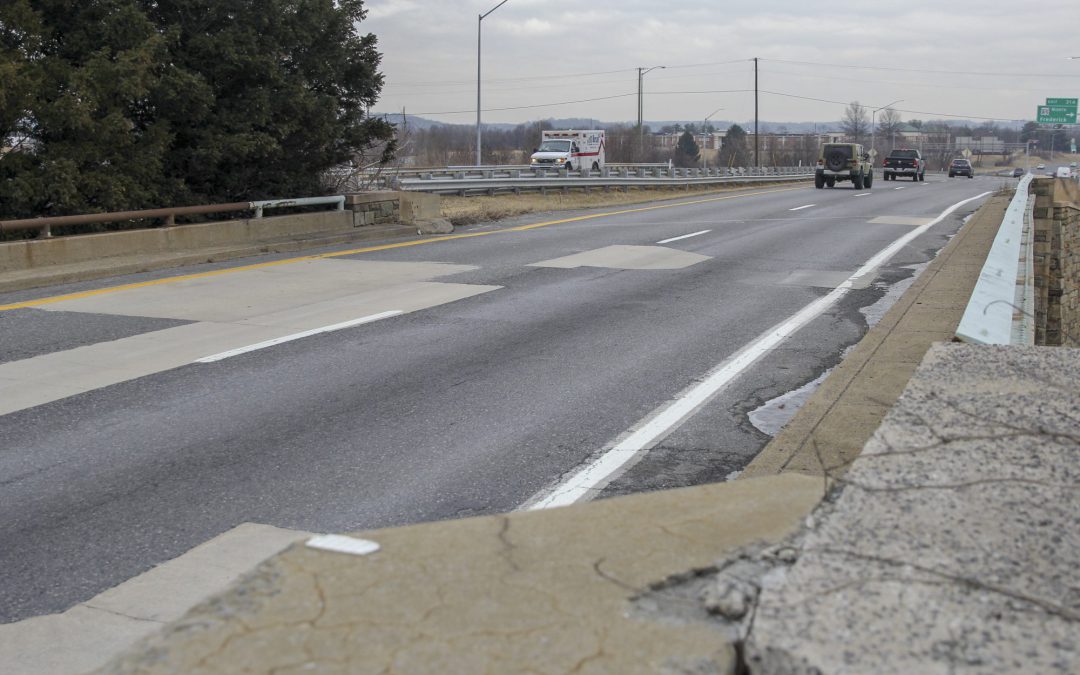WASHINGTON – Frederick County’s bridges are in better shape than the national average, but improvements are still needed, according to newly released data from the Federal Highway Administration.
According to the 2017 National Bridge Inventory, over 50,000 of America’s 612,677 bridges – 8.9 percent – are structurally deficient. But only 5.6 percent – 299 – of Maryland’s 5,335 bridges, are structurally deficient.
Frederick County is doing better than both. Of the county’s 475 bridges, 21 are structurally deficient. That’s only 4.4 percent, or a little less than half the national average.
Charlie Gischlar, spokesman for the Maryland State Highway Administration, said the good numbers come after a lot of statewide investment – nearly $170 million per year for the last three years.
“Of the more than 2,500 [bridges] that we own, 69 were identified as structurally deficient back in 2015,” Gischlar said. “It’s only 2.6 percent of our inventory … we’re one of the best in the nation.”
The Federal Highway Administration measures the condition of the bridge deck, which is what you drive over, superstructure and substructure, and issues grades on a nine-point scale. If any elements score poorly – a rating of four or below – the bridge is classified as structurally deficient.
“That doesn’t mean the bridge is going to fall down,” Gischlar said. “It just means it has fallen into a state of disrepair, so it needs to be either rehabilitated or completely replaced.”
The state maintains nine of Frederick County’s structurally deficient bridges and has ongoing or future projects to repair or replace eight of them. Among those are the county’s two busiest bridges – Interstate 270 northbound and southbound over Md. 85, which both carry over 100,000 cars per day. Both are expected to be replaced as part of the widening of Md. 85.
“Instead of having two bridges on the project, we’re going to have one bridge,” Gischlar said. “That is supposed to be completed, and I mean everything done – planted, the construction trailer towed away, by early 2021.”
Eight of the county’s structurally deficient bridges are maintained by the county, three by the city of Frederick, and one by Thurmont.
Vivian Laxton, spokeswoman for Frederick County, said the county receives about $2.5 million in federal funding each year to evaluate and replace bridges on a six-year cycle as part of the county’s capital investment program.
“That money is specifically for the road and bridge rehabilitation project,” Laxton said. “Everything that’s on the list that hasn’t already been repaired is scheduled to get repaired or replaced, the last one l believe is in fiscal year 2024.”
● – Bridge owned by Frederick County
◆ – Bridge owned by the City of Frederick
■ – Bridge owned by the town of Thurmont
✓ – Bridge listed as structurally deficient in FHWA data, has been repaired or replaced.
✱ – Ongoing or future construction to repair or replace bridge.
While Maryland and Frederick County have made progress, infrastructure investment on a national level is still sorely needed, according to Brian Pallasch, managing director of government relations and infrastructure initiatives for the American Society of Civil Engineers.
“The federal government’s been behind in infrastructure investment – some would say they’ve taken a generation off,” Pallasch said. “The last time we raised the federal motor fuel tax was in 1993. That means that the tax, which is 18 cents at the federal level, has lost about 40 percent of its purchasing power.”
President Donald Trump made infrastructure investment a major component of his campaign and said in the State of the Union address that he wants Congress to pass a bill that would provide $200 billion in federal funds over 10 years with incentives to get state governments and private companies to invest $1.3 trillion more.
Pallasch said the proposed numbers are good, but not enough.
“That’s still only $20 billion a year,” Pallasch said. “That’s certainty going to be beneficial, but it’s not going to fill the $2 trillion infrastructure deficit we have.”
U.S. Rep. John Delaney, D-6th, whose congressional district includes parts of Frederick County, said he supports a bipartisan approach to infrastructure investment and is waiting to see Trump’s full plan before passing judgment. But Delaney also said more federal funding is needed.
“Our infrastructure pothole is way too big to patch over with a press release, it’s going to take real money,” Delaney said in an emailed statement. “Moreover, a lot of smaller projects, especially in rural locations, aren’t going to attract private investment. This is why I made an infrastructure bank a part of my bipartisan infrastructure plan, because this kind of vehicle would give state and local governments another option.”




